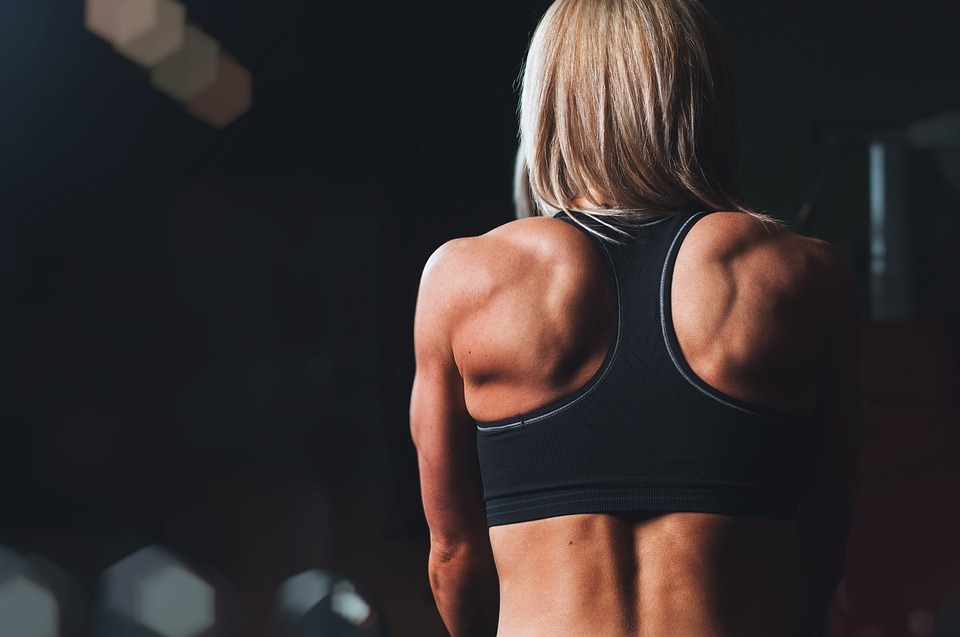Anecdotal evidence aside, there is some logic to training the back and biceps together that allows you to work both muscle groups hard.
This guide will teach you how to create workouts that are efficient for upper-body growth and development, specifically for increasing back and arm size .
Why Work Your Back and Biceps Together?
When you think about training your back, the biceps will be the secondary or tertiary muscle that is used in any sort of row, pulldown, or pullup. It is more efficient to work the biceps in conjunction with compound lifts that involve more than one joint, as opposed to biceps exercises where only the elbow flexes.
Exercises that target the back and biceps muscles are typically started with rowing or pulldown movements in order to work the larger back muscles while the person is still feeling strong. Doing biceps curls at the beginning of your workout would make your arms too tired to help you with back exercises later, so it makes more sense to wait and do them after you’ve already worked out your back.
The most popular workout split among people who lift weights is the push-pull split, where you train the muscles that push one day, and the muscles that pull the next. For example, you could work on your chest, shoulders, and triceps on Monday, and then do your back, biceps, glutes, and hamstrings on Tuesday. A schedule like this is easy to follow and makes sure you don’t miss any workouts for certain muscle groups.
You don’t have to train your whole body each day. One way to structure your workout week is to do upper-body pushing one day, followed by upper-body pulling the next day, and then a leg day later in the week. A back and biceps session flows nicely with all variations of the push-pull split.
Back and Biceps Anatomy
The major muscles involved when training back and biceps include:
Back*
– Latissimus dorsi (aka, the “lats”). The large muscles located on either side of the spine that enable one to move their arms in a downward and backward motion are called latissimus dorsi.
– Teres major. The muscle located below your shoulder that helps you move your arms down and back.
– Rhomboids. The muscles in the upper back that are responsible for lifting, pulling back, and rotating the shoulder blades down.
– Middle and lower trapezius (“traps”). These guys retract and depress the shoulder blades.
Biceps
– Biceps brachii. The main biceps muscle twists the wrist outward and flexes the elbow.
– Brachialis. The muscle located on the outer side of your arm, between your biceps and triceps, is called the deltoid muscle. It flexes the elbow.
*When discussing “back training” in strength and conditioning circles, experts are usually referring to the upper back. The muscles in your lower back, known as the erector spinae, are a key part of your core musculature. These muscles play an important role in leg exercises such as deadlifts and squats. You can include lower-back exercises in your back and biceps workouts, but be aware of how much stress other workouts may be putting on the area. Don’t overwork it.
How Many Back Exercises And Biceps Exercises Should I Do?
The back and biceps work together on most upper-body pulling movements, but the amount of work each group can handle is different. According to Rusin, four to six exercises for back and biceps is ideal in a workout, with a two-to-one ratio of back to biceps exercises. At the high end, you would do four back exercises and two biceps exercises that isolate the biceps in a session.
You can train your back multiple days a week, Rusin says. Even though your back muscles work hard all day to help you keep good posture, they are tough and can handle a lot of strain. The biceps need more rest between workouts,” Although the biceps can’t handle the same amount of training volume and frequency as the back, they still need more rest between workouts. A lot of people think that the best way to work out their back and biceps is to do an equal number of exercises for each muscle group. However, this is not the most effective way to stay healthy and see results in the long term.
Small muscles, like the biceps, generally recover faster than larger muscles. The biceps are used to move the elbows and shoulders, which are two areas of the body that it is not advisable to overwork, especially when you are already training other parts of the chest, arms, and shoulders during the week.
According to Rusin, too much dedicated biceps training can be bad for shoulder and elbow health and recoverability, even for professional bodybuilders.
How Many Sets and Reps Should I Do for Back and Biceps?
If you are doing a lot of exercises, it is a good idea to do 2-3 sets per exercise. A working set is when you’re using a load that is challenging and close to failure (within one or two reps of failure).
In many cases, you won’t hit the aforementioned two-to-one ratio of back to biceps exercises perfectly; for example, you may do 3 back exercises and 2 for biceps. This is totally fine, as long as you make sure to hit both muscle groups equally hard during your workout. In these instances, shoot for a two-to-one ratio of total sets for back and biceps (6 sets for back, 3 sets for biceps).
Rusin suggests 8 to 25 repetitions for back exercises (with a 45 to 75 second rest between sets). Doing 10 reps of biceps all the way up to 50 resting in 20-45 seconds in between.
According to Rusin, you can focus on either strength or muscle growth when working on your back, but with biceps there is no need to worry about strength. The elbows are not meant to lift ever-increasing weights, so it is best to train them for hypertrophy (max muscle gain) by going for a big pump. “That’s what the biceps respond best to,” says Rusin.
The Workout: 45-Minute Back and Biceps Workout With Supersets
For each set, you will do the exercises without resting, and then rest for 30 to 60 seconds before repeating the set. Choose a weight that you can lift with good form for each exercise. The last rep should be challenging but not impossible.
For a lighter workout, complete each superset one time. If you want a more challenging workout, repeat each superset three times. You can increase or decrease the length of your workout by changing the number of sets you complete.
Supersets that focus on the back muscles are a great way to start if you’re looking to build and strengthen those muscles. Complete the biceps supersets first if you want to focus on your biceps.
Superset #1
The first superset on the workout will involve two variations of a row exercise to target the large muscles in the back. The movements will also improve your shoulders and arms.
One-Armed Row
You’ll need heavy dumbbells for this exercise. You may find it helpful to prop your arm and upper body against a bench to support your lower back.
- Place your left foot a few feet in front of you with your knee bent, and hold a heavy weight in your right hand. The palm should be facing the midline of the body.
- Keeping the back strong and the core tight, engage the muscles in your back to pull the elbow up in a rowing motion until it is level with your torso.
- Lower and repeat for 10–12 reps, then switch sides.
Barbell High Row
Start this exercise standing with your feet hip-width apart and a barbell in front of you on the floor. If you are adding weight to the bar, be sure that the weight plates are secured with a weight collar. If you don’t have a barbell, you can just hold a dumbbell in each hand. To start, grab the barbell with an overhand grip, and position your palms towards your thighs.
- Bend your knees slightly and hinge at the hips, bringing the torso forward until your back is almost parallel to the floor. Let the barbell hang in front of you.
- Squeeze your shoulder blades together and engage the middle and upper back as you pull the weight toward your chest.
- Lower the barbell and repeat for 10–12 reps.
After completing the barbell high row, repeat superset #1.
Superset #2
Next, you will do two different types of rows to continue working the muscles in the back and shoulders.
Upright Row
You can perform this exercise with dumbbells in each hand if you don’t have a barbell available. Stand tall holding the barbell with an overhand grip, so your palms are facing your body. Hands should be shoulder-width apart.
- Keeping the abdominals engaged, lift the barbell straight up toward your chin, leading with the elbows and keeping the bar close to the body.
- Pause when the bar reaches shoulder height.
- Return the barbell back to the starting position and repeat 10–12 times.
Alternating T-Pulls and Y-Pulls
You’ll use a resistance band for this exercise. You can do this exercise by standing and using TRX straps instead of working out in a gym or at home.
You should start by sitting down with your legs extended in front of you if you are using bands. Hold one end of the band in each hand and loop it around both feet. There should be barely any slack in the band.
- Keeping a strong, tall back, engage your middle and upper back and open your arms out to a T-shape.
- Return to the starting position and repeat, but this time, bring your arms up and out into a Y-shape.
- Return to the starting position and continue alternating T-pulls and Y-pulls for 10–12 repetitions.
Complete superset #2 again.
Superset #3
Now you will begin doing supersets that focus on the front of the body, particularly the biceps. Begin the workout with two biceps curl variations while standing.
Barbell Curl
Start with your feet hip-width apart and abdominals engaged. Grip the barbell in front of you with your palms facing forward and your fingers wrapped around the bar. If you don’t have a barbell, two dumbbells can be held one in each hand.
- Keeping your upper arms stable and shoulders relaxed, bend at the elbow and lift the barbell so that it approaches your shoulders. The elbows should stay tucked in close to the ribs.
- Lower the barbell to the starting position and repeat 10–12 times.
Reverse Curl
To do a reverse dumbbell curl, you will hold one dumbbell in each hand using an overhand grip. Your palms should face your thighs when you begin.
- Bending at the elbow, lift the weights up toward your shoulders but pause when your elbows reach a 90-degree bend (or slightly higher).
- Slowly lower the weights with control to the starting position.
- Repeat the exercise for 10–12 repetitions.
After completing your reverse curls, repeat superset #3.
Superset #4
This last set provides two more exercises to work the biceps. You’ll need dumbbells to perform each exercise.
Hammer Curls
start by standing with your feet about hip-width apart, holding one dumbbell in each hand with your palms facing your thighs
- Keeping your upper arms in a fixed position, bend at the elbow and lift your lower arms up and toward your shoulders.
- At the top of the movement, your thumbs will be close to your shoulders, palms facing in toward the midline of the body.
- Lower the weights to the starting position and repeat 10–12 times.
Concentration Curl
This exercise allows you to focus on one arm at a time, giving each arm an equal workout. You’ll start seated on a chair or weight bench. Hold a dumbbell in your right hand with your arm extended straight down, but propped up against the inside of your right thigh.
- Engage the bicep and curl the weight towards your shoulder. Keep the elbow pressed against the right leg so it remains stable.
- Lower the weight to the starting position and repeat 10–12 times. Repeat with the left arm.
After completing your concentration curls, repeat superset #4.
Cool Down
It is best to cool down gradually by walking on a treadmill at an easy pace, or pacing the room if your heart rate is elevated. In addition to your lower body workout, you can also take the opportunity to stretch your upper body muscles while they are warm.



